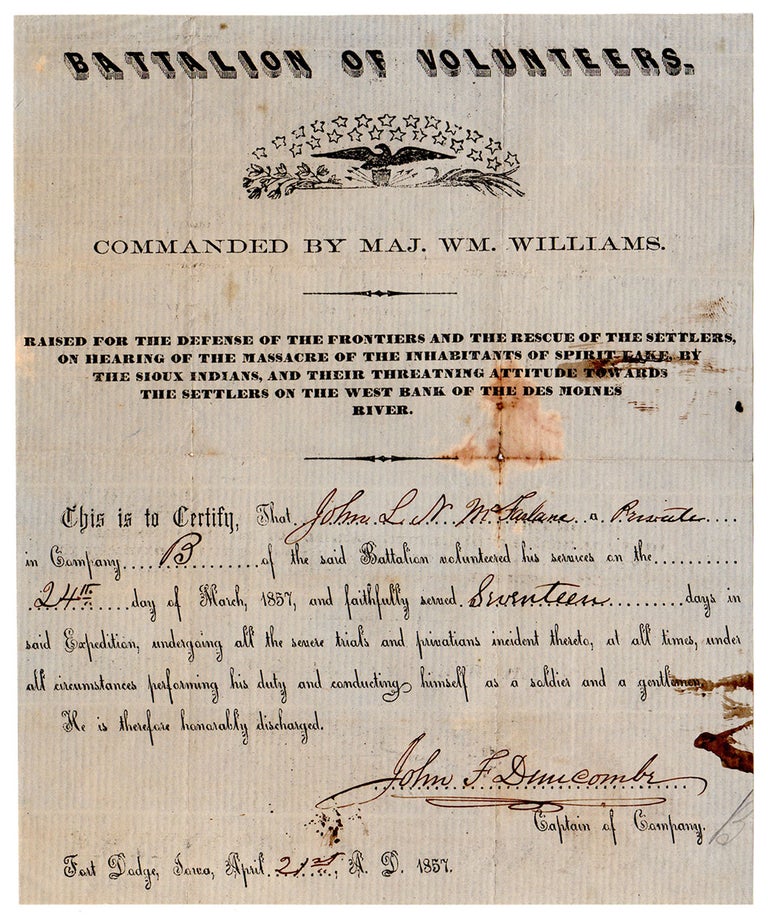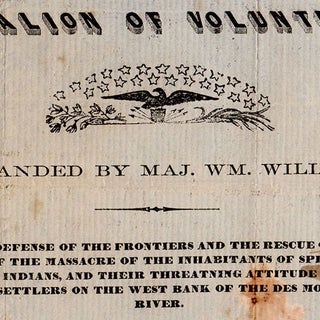Battalion of Volunteers. Commanded By Maj. Wm. Williams. Raised for the Defense of the Frontiers and the Rescue of the Settlers, On Hearing of the Massacre of the Inhabitants of Spirit Lake, By the Sioux Indians, and Their Threatening Attitude Towards the Settlers on the West Bank of the Des Moines River.
Fort Dodge, Iowa, 21 April 1857. Broadside 21.2 x 17.5 cm. A rare discharge certificate relating to the aftermath of the Spirit Lake Massacre which saw a frontier volunteer party undertake a treacherous winter expedition to pursue the hostile Sioux, guard against further attacks upon settlers, bury the dead, and attempt to recover four female hostages seized by the Indians. Occurring between 8 and 12 March 1857, the Spirit Lake Massacre was a series of attacks carried out by a Wahpekute band of Santee Sioux on dispersed Iowa frontier homesteads during an especially harsh winter. Suffering a shortage of food, chief Inkpaduta (Scarlet Point) and fourteen Sioux raided settlements near Okoboji and Spirit Lakes in northwestern Iowa near the Minnesota border. The attack was also apparently in retribution for the 1854 murder of Inkpaduta’s brother, Sidominadotah and his brother’s family by white settler Henry Lott. The Sioux killed more than 30 settlers—many of whom were scalped—and took four young women captive—the youngest being Ms. Abbie Gardner, who was kept for several months and would later write, History of the Spirit Lake Massacre and the Captivity of Miss Abbie Gardner (1885). Upon learning of the raids, Minnesota Governor James Grimes and a U.S. Indian Agent assembled a militia relief party to protect settlers in the lake region from further attacks. However, due to heavy snows and extremely rough going, the expedition—originating from Fort Dodge and Webster City—did not make it in time to defend Springfield, Minnesota, which was attacked by the Indians. The present document, dated 24 March 1857, records the service of John L. N. McFarlane, a private in Company B of the 91-man relief party from Fort Dodge, consisting of two companies of volunteers. This unusual document honorably discharges McFarlane and certifies that he served seventeen days in the expedition, during which he endured “all the severe trials and privations incident thereto, at all times, under all circumstances performing his duty and conducting himself as a soldier and a gentleman.” The text is signed by Capt. John F. Duncombe, who headed Company B. The perilous relief effort has been chronicled in Thomas Teakle’s The Spirit Lake Massacre. Teakle asserts that “the trials and sufferings of this little volunteer band have few if any parallels in the pioneer history of the Mississippi Valley. Unprepared for such a venture as the journey proved to be, they nevertheless met its ordeals with a courage that attests the hardihood of the pioneers who chose the task of advancing the frontier.” Major William Williams—the first mayor and first citizen of Fort Dodge—was selected by Governor Grimes to command the party and was the only man with military experience. As Teakle details, the going was nothing short of brutal:
With snow nearly four feet deep on the level, and with ravines, gulches, and low places completely filled, they encountered from the beginning almost endless difficulties in marching and in the transportation of supplies. Not a man was intimately acquainted with the surrounding country. Frequently they found themselves plunged into snow-filled creek beds where with the oxen they floundered vainly for some time in more than fifteen or twenty feet of drifted snow before they gained the lesser depth beyond.
With temperatures as low as 30 degrees below zero, the relief party was plagued by persistent and unremitting hunger, wetness, exposure to intense cold, numbness, snow-blindness, sunburns, illness, and so on. Two men froze to death and many others nearly perished on the frigid open plains. While there were many signs of Indians during their expedition, they never actually crossed their path. In one instance, the relief party mistook a group of refugees fleeing Springfield for a party of the Wahpekute:
Suddenly [Mr.] Church gave a shout and sprang forward exclaiming: “My God, there’s my wife and babies!” The “Indians” turned out to be none other than the refugees from Springfield, Minnesota. The meeting was both dramatic and pathetic. For days relatives and friends of the refugees had believed them dead—victims of Indian barbarities. Now some were reunited with their loved ones, while others received word that their kin were lying in the snows of the lake region or had been carried away in captivity by the Indians.
Upon nearing Spirit lake, a detail of men was sent to bury the dead, whereupon one Mr. Thatcher found the remains of his infant child amongst the mutilated bodies of the victims. While many were buried, others remained missing.
Following the relief party’s return, a later expedition was sent out from Fort Ridgely, Minnesota in pursuit of Inkpaduta and his men—but to no avail. Despite the call for retaliation, authorities in the region chose not to take action against the Sioux until the captives had been returned. Upon finally making contact with Inkpaduta’s band, it was discovered two of the captives had been killed. By the summer of 1857, Margaret Ann Marble and Abbie Gardner were successfully recovered. During this time local authorities further pursued the hostile band with troops and allied Sioux warriors. This expedition was largely unsuccessful and the Sioux subsequently declined to undertake further missions.
A rare document relating to the last Indian attack in Iowa history.
REFERENCES: Teakle, Thomas. The Spirit Lake Massacre (Iowa City, Iowa: State Historical Society of Iowa, 1918), chapters XXI-XXV. Michno, Susan J. Spirit Lake Massacre at historynet.com
CONDITION: Good, minor ink stains and light soiling on recto, tiny punctures along old folds.
Item #5100
Price: $2,250.00




